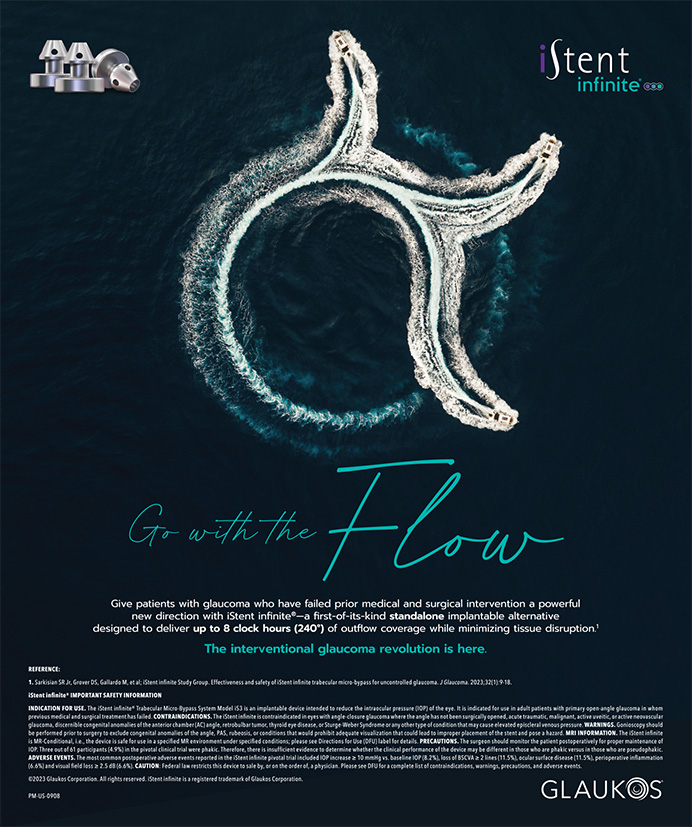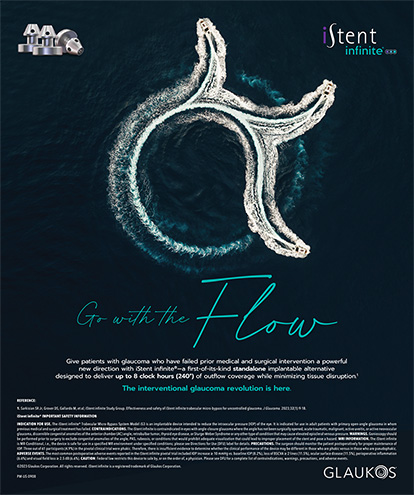

Predicting Axial Length in Patients With Marfan Syndrome and Ectopia Lentis After Modified Capsular Tension Ring and Intraocular Lens Implantation
Chen ZX, Jia WN, Ma Y, et al1
Industry support: None
ABSTRACT SUMMARY
This consecutive retrospective case series sought to predict axial length (AL) growth in patients with Marfan syndrome (MFS) and ectopia lentis (EL). Investigators developed a multivariate linear regression model for AL growth rate (RALG). Eyes that had received a modified capsular tension ring (MCTR) and IOL were evaluated. A total of 128 patients were enrolled.
Study in Brief
A consecutive retrospective case series found that axial length (AL) growth followed a logarithmic pattern and ceased at about 15 years of age in patients with Marfan syndrome (MFS) and ectopia lentis. Patients with MFS and a greater preoperative AL experienced a higher rate of AL growth after lens surgery. The prediction model could help surgeons optimize IOL power selection for this patient population.
WHY IT MATTERS
IOL power selection for pediatric eyes is complex, largely owing to ongoing AL growth. A significant number of children who require IOLs also have connective tissue disorders such as MFS. At present, surgeons primarily choose the IOL power and determine the undercorrection with an age-directed nomogram. This approach does not account for individual variations, making it challenging to predict long-term refractive outcomes. The multivariate linear regression model for AL growth rate developed in this study is designed to allow personalized IOL power selection based on the predicted AL.
RALG was independent of age between 3 and 15 years and decreased to 0 thereafter. Preoperative AL was associated with RALG in patients younger than 15 years of age. A postoperative AL prediction model was established for patients with MFS who were between the ages of 3 and 15 years. A Python-based calculator was developed to assist with IOL power selection.
DISCUSSION
The development and maintenance of emmetropia are coordinated by increasing AL and concomitant lenticular changes. Long-term refractive outcomes in pseudophakic eyes are largely determined by AL because the IOL power is fixed. Studies have assessed AL growth in healthy and pathologic eyes, but research on eyes with EL has lagged.
Chen and colleagues found a higher RALG in patients with MFS and EL who had a greater preoperative AL. The researchers developed a log10-transformation model to predict future AL in patients who were between 3 and 15 years of age. The investigators also identified a rapid stage of AL growth in patients younger than 2 years of age regardless of the presence of a cataract.
Understanding the law of alpha (AL) growth is important when implanting an IOL in a pediatric eye. Previous studies have shown accelerated AL growth in the unilateral pseudophakic eye compared to the bilateral pseudophakic eye in the setting of a congenital cataract. The comparison of AL growth, however, in the unilateral pseudophakic eye and fellow normal eye in patients with unilateral congenital cataracts has been controversial.
Accurately predicting AL growth helps surgeons achieve the target refraction when the eye fully develops. The current literature on AL prediction in eyes with EL is limited. The IOL calculator developed by Chen et al to facilitate the application of their AL prediction model holds promise but requires validation.
Surgical Outcomes of Modified Capsular Tension Ring and Intraocular Lens Implantation in Marfan Syndrome With Ectopia Lentis
Chen Z, Zhang M, Deng M, Chen T, Chen J, Zheng J, Jiang Y2
Industry support: None
ABSTRACT SUMMARY
This retrospective case series assessed the surgical outcomes of MCTR and IOL implantation in 109 patients (187 eyes) with MFS. Mean follow-up was approximately 10 months.
Study in Brief
A retrospective case series found phacoemulsification combined with transscleral modified capsular tension ring fixation and IOL implantation in the bag to be safe and effective for managing ectopia lentis in patients with Marfan syndrome. Postoperatively, the average logMAR BCVA of approximately 90% of eyes improved significantly. More than 70% of eyes attained a visual acuity of 20/40 or better despite a high rate (> 90%) of amblyopia before surgery. The most frequent postoperative complications were posterior capsular opacification and decentered anterior capsular opacification. Long-term observation—particularly during the first 2 years following surgery—was recommended.
WHY IT MATTERS
The procedure holds promise for improving the vision of patients with Marfan syndrome, but realistic expectations must be set preoperatively.
The MCTR was sutured to the sclera with a specialized technique. Primary outcome measures were the patient’s visual acuity and postoperative complications.
Patients’ visual acuity improved significantly following surgery (P < .001). Major complications included posterior capsular opacification (PCO) in 41 eyes (23.56%) and decentered anterior capsular opacification (ACO) in 15 eyes (8.62%). No eye experienced suture breakage or IOL dislocation.
The investigators concluded that the procedure can significantly improve the visual acuity of patients with MFS but that long-term observation—especially during the first 2 years—is essential.
DISCUSSION
Phacoemulsification combined with transscleral MCTR fixation and IOL implantation in the bag was found to be safe and effective for managing congenital EL. The visual acuity of about 90% of eyes improved postoperatively, with a significant improvement in mean logMAR BCVA. Despite the high incidence of preoperative amblyopia, more than 70% of eyes achieved a Snellen visual acuity of 20/40 or better.
Preservation of the capsular bag led to complications, most commonly PCO and decentered ACO. Although CTR implantation has been reported to hinder PCO formation, the eyelets of an MCTR may facilitate the migration of lens epithelial cells from the anterior capsulorhexis to the posterior capsule. Decentered ACO in MFS eyes has not previously been reported in the literature. These eyes are at increased risk of retinal detachment primarily due to high rates of progressive lens subluxation and axial elongation. Lensectomy combined with a limbal or pars plana vitrectomy has traditionally been performed before IOL implantation. The rate of postoperative retinal detachment, however, is high in MFS eyes that undergo lensectomy combined with vitrectomy, especially those with a high degree of EL and a long AL.3
The study by Chen et al highlighted the importance of maintaining asepsis, avoiding corneal penetration, and perioperatively administering antibiotic eye drops when removing the corneal suture. The first 2 years after surgery were crucial; the mean occurrences of PCO and decentered ACO were at 9.44 ±7.08 and 8.87 ±15.08 months, respectively. Long-term observation was therefore recommended.
1. Chen ZX, Jia WN, Ma Y, et al. Predicting axial length in patients with Marfan syndrome and ectopia lentis after modified capsular tension ring and intraocular lens implantation. J Cataract Refract Surg. 2023;49(6):571-577.
2. Chen Z, Zhang M, Deng M, et al. Surgical outcomes of modified capsular tension ring and intraocular lens implantation in Marfan syndrome with ectopia lentis. Eur J Ophthalmol. Published online April 22, 2021. doi:10.1177/11206721211012868
3. Fan F, Luo Y, Liu X, Lu Y, Zheng T. Risk factors for postoperative complications in lensectomy-vitrectomy with or without intraocular lens placement in ectopia lentis associated with Marfan syndrome. Br J Ophthalmol. 2014;98(10):1338-1342.




